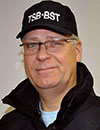Aviation Investigation A16W0170
Runway incursion
The occurrence
On 2 December 2016 at 1650 Mountain Standard Time, an Air Canada Airbus A320 operating as flight AC221 from Calgary, Alberta to Vancouver, British Columbia was cleared to take-off on Runway 29 at the Calgary International Airport [CYYC]. At approximately 2200 feet into the take-off roll, the flight crew observed a Sunwest Aviation Ltd. Swearingen SA-226-TC crossing Runway 29 from south to north on Taxiway Alpha. The SA-226 had been cleared to cross Runway 29 to taxi to the northwest hangar line. Since the SA-226 was more than 50% across Runway 29 when AC221 made visual contact, the takeoff was continued, without further event.
Map of the area
Investigator-in-Charge

Gerrit B. Vermeer started his professional aviation career by joining the Mission Aviation Fellowship and moving to Southern Africa. During his time there, he served as a line pilot as well as Acting Chief pilot and Operations Manager. Upon returning to Canada, Mr. Vermeer flew for a charter operator out of the Edmonton International Airport, serving the oil and gas industry. In 2008, he joined Transport Canada (TC) and, for five and a half years, worked as an inspector in the Enforcement Branch. During a major reorganization of TC, Mr. Vermeer transferred to the Operations division of the Prairie and Northern Region and, for the next year, served as a Principal Operations Inspector for a number of northern operators.
Mr. Vermeer has a Bachelor’s degree in Mission Aviation Technology and currently holds a fixed wing airline transport pilot licence with approximately 6400 hours of flight time. He also holds a Canadian aircraft maintenance engineer license, as well as an airframe and powerplant technician license issued by the USA's Federal Aviation Administration.
Transportation Safety Board investigation process
There are 3 phases to a TSB investigation:
- Field phase: a team of investigators examines the occurrence site and wreckage, interviews witnesses and collects pertinent information.
- Examination and analysis phase: the TSB reviews pertinent records, tests components of the wreckage in the lab, determines the sequence of events and identifies safety deficiencies. When safety deficiencies are suspected or confirmed, the TSB advises the appropriate authority without waiting until publication of the final report.
- Report phase: a confidential draft report is approved by the Board and sent to persons and corporations who are directly concerned by the report. They then have the opportunity to dispute or correct information they believe to be incorrect. The Board considers all representations before approving the final report, which is subsequently released to the public.
For more information, see our Investigation process page.
Media
TSB deploys a team of investigators to the site of an aircraft accident in Powell River, British Columbia
Read the deployment notice
- Date modified:
